Research: SCOR Model Implementation in FMCG Environment, ITC Limited
VerifiedAdded on 2020/04/13
|73
|16380
|36
Project
AI Summary
This research project investigates the implementation of the Supply Chain Operating Reference (SCOR) model within ITC Limited, a major fast-moving consumer goods (FMCG) company in India. The study explores the application of the SCOR model, which encompasses the Plan, Source, Make, Deliver, and Return processes, to enhance supply chain efficiency. The research aims to identify factors crucial for successful SCOR model implementation, evaluate its processes in the FMCG environment, and analyze challenges encountered during integration. Employing a positivism philosophy and a mixed-methods approach, the study analyzes both quantitative and qualitative data collected from employees and managers. The findings address technological advancements, knowledge base requirements, competitive advantages, material flow improvements, information streamlining, and the impact of packaged software solutions. Additionally, the research identifies key challenges such as human resource management issues and the absence of quality metrics, offering insights into the complexities of SCOR model implementation in a dynamic FMCG setting. The project includes an extensive literature review, detailed methodology, data collection, interpretation, and conclusions, along with tables, charts and images to support the analysis.
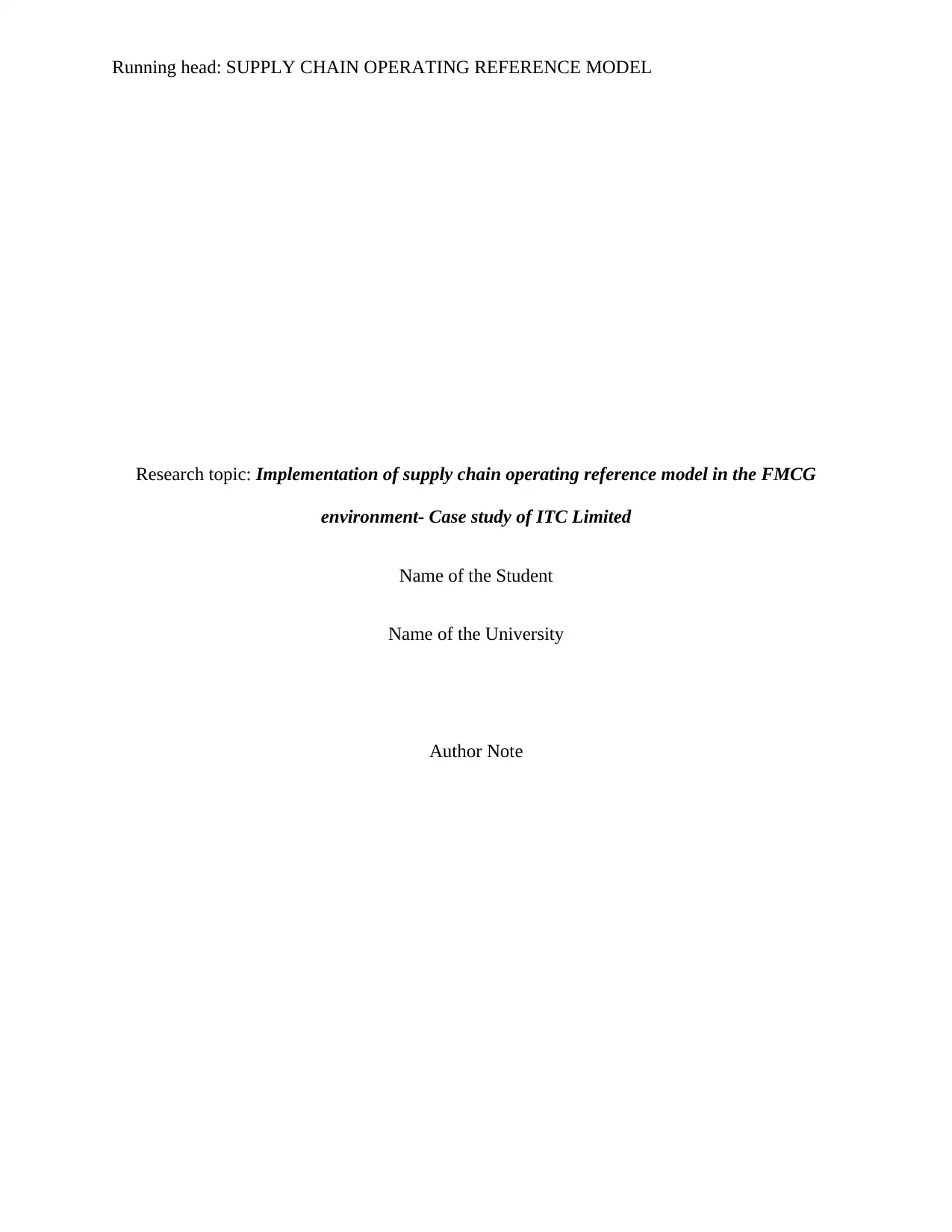
Running head: SUPPLY CHAIN OPERATING REFERENCE MODEL
Research topic: Implementation of supply chain operating reference model in the FMCG
environment- Case study of ITC Limited
Name of the Student
Name of the University
Author Note
Research topic: Implementation of supply chain operating reference model in the FMCG
environment- Case study of ITC Limited
Name of the Student
Name of the University
Author Note
Paraphrase This Document
Need a fresh take? Get an instant paraphrase of this document with our AI Paraphraser
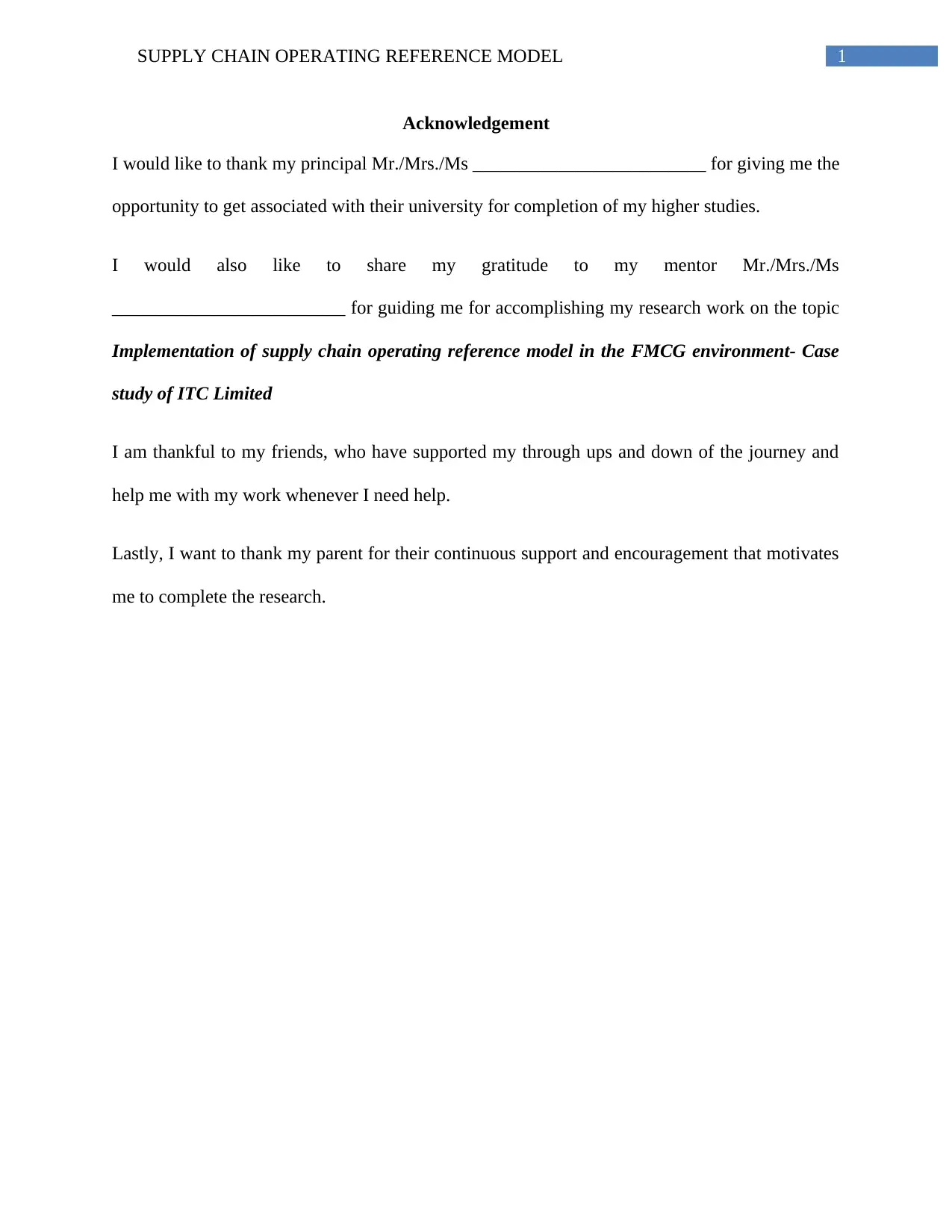
1SUPPLY CHAIN OPERATING REFERENCE MODEL
Acknowledgement
I would like to thank my principal Mr./Mrs./Ms _________________________ for giving me the
opportunity to get associated with their university for completion of my higher studies.
I would also like to share my gratitude to my mentor Mr./Mrs./Ms
_________________________ for guiding me for accomplishing my research work on the topic
Implementation of supply chain operating reference model in the FMCG environment- Case
study of ITC Limited
I am thankful to my friends, who have supported my through ups and down of the journey and
help me with my work whenever I need help.
Lastly, I want to thank my parent for their continuous support and encouragement that motivates
me to complete the research.
Acknowledgement
I would like to thank my principal Mr./Mrs./Ms _________________________ for giving me the
opportunity to get associated with their university for completion of my higher studies.
I would also like to share my gratitude to my mentor Mr./Mrs./Ms
_________________________ for guiding me for accomplishing my research work on the topic
Implementation of supply chain operating reference model in the FMCG environment- Case
study of ITC Limited
I am thankful to my friends, who have supported my through ups and down of the journey and
help me with my work whenever I need help.
Lastly, I want to thank my parent for their continuous support and encouragement that motivates
me to complete the research.
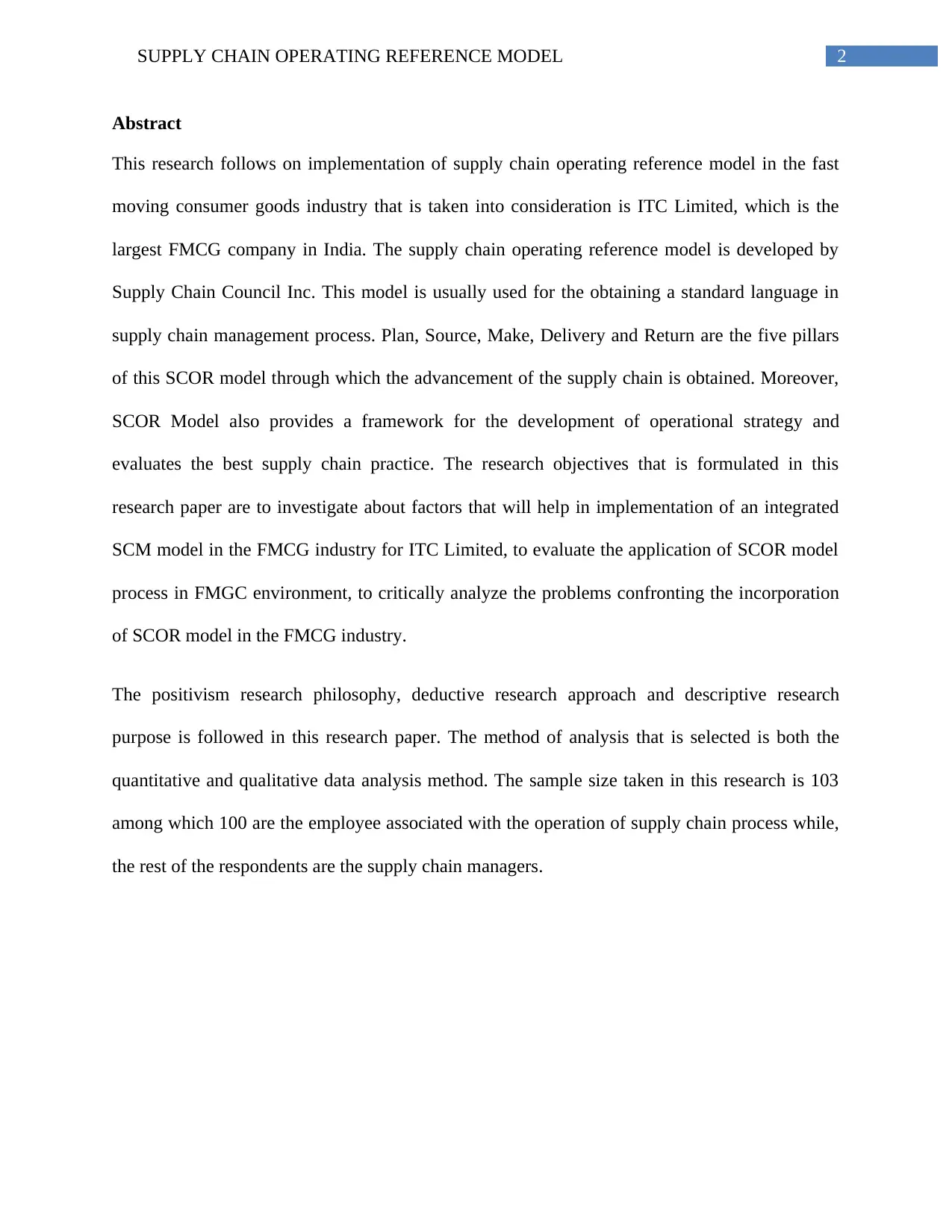
2SUPPLY CHAIN OPERATING REFERENCE MODEL
Abstract
This research follows on implementation of supply chain operating reference model in the fast
moving consumer goods industry that is taken into consideration is ITC Limited, which is the
largest FMCG company in India. The supply chain operating reference model is developed by
Supply Chain Council Inc. This model is usually used for the obtaining a standard language in
supply chain management process. Plan, Source, Make, Delivery and Return are the five pillars
of this SCOR model through which the advancement of the supply chain is obtained. Moreover,
SCOR Model also provides a framework for the development of operational strategy and
evaluates the best supply chain practice. The research objectives that is formulated in this
research paper are to investigate about factors that will help in implementation of an integrated
SCM model in the FMCG industry for ITC Limited, to evaluate the application of SCOR model
process in FMGC environment, to critically analyze the problems confronting the incorporation
of SCOR model in the FMCG industry.
The positivism research philosophy, deductive research approach and descriptive research
purpose is followed in this research paper. The method of analysis that is selected is both the
quantitative and qualitative data analysis method. The sample size taken in this research is 103
among which 100 are the employee associated with the operation of supply chain process while,
the rest of the respondents are the supply chain managers.
Abstract
This research follows on implementation of supply chain operating reference model in the fast
moving consumer goods industry that is taken into consideration is ITC Limited, which is the
largest FMCG company in India. The supply chain operating reference model is developed by
Supply Chain Council Inc. This model is usually used for the obtaining a standard language in
supply chain management process. Plan, Source, Make, Delivery and Return are the five pillars
of this SCOR model through which the advancement of the supply chain is obtained. Moreover,
SCOR Model also provides a framework for the development of operational strategy and
evaluates the best supply chain practice. The research objectives that is formulated in this
research paper are to investigate about factors that will help in implementation of an integrated
SCM model in the FMCG industry for ITC Limited, to evaluate the application of SCOR model
process in FMGC environment, to critically analyze the problems confronting the incorporation
of SCOR model in the FMCG industry.
The positivism research philosophy, deductive research approach and descriptive research
purpose is followed in this research paper. The method of analysis that is selected is both the
quantitative and qualitative data analysis method. The sample size taken in this research is 103
among which 100 are the employee associated with the operation of supply chain process while,
the rest of the respondents are the supply chain managers.
⊘ This is a preview!⊘
Do you want full access?
Subscribe today to unlock all pages.

Trusted by 1+ million students worldwide
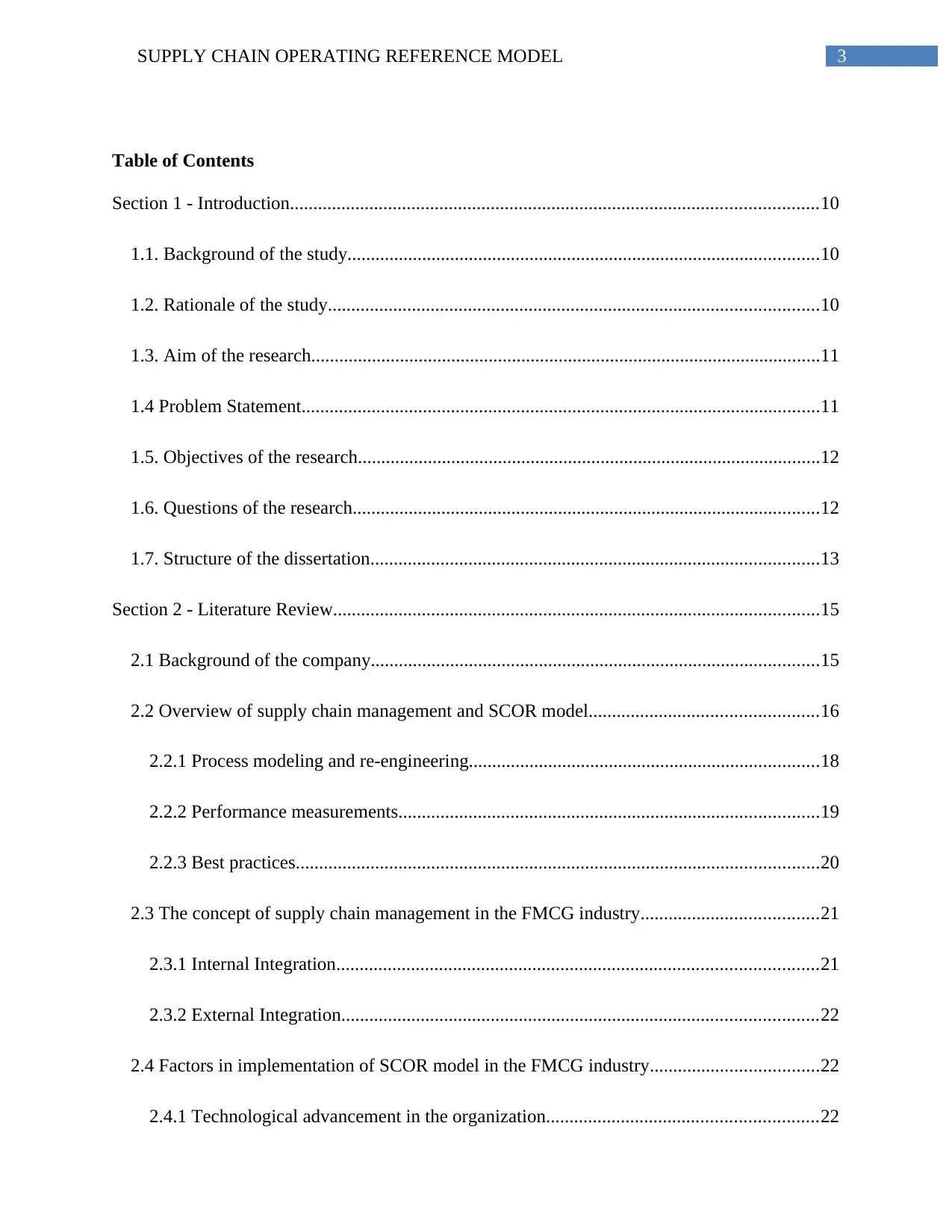
3SUPPLY CHAIN OPERATING REFERENCE MODEL
Table of Contents
Section 1 - Introduction.................................................................................................................10
1.1. Background of the study.....................................................................................................10
1.2. Rationale of the study.........................................................................................................10
1.3. Aim of the research.............................................................................................................11
1.4 Problem Statement...............................................................................................................11
1.5. Objectives of the research...................................................................................................12
1.6. Questions of the research....................................................................................................12
1.7. Structure of the dissertation................................................................................................13
Section 2 - Literature Review........................................................................................................15
2.1 Background of the company................................................................................................15
2.2 Overview of supply chain management and SCOR model.................................................16
2.2.1 Process modeling and re-engineering...........................................................................18
2.2.2 Performance measurements..........................................................................................19
2.2.3 Best practices................................................................................................................20
2.3 The concept of supply chain management in the FMCG industry......................................21
2.3.1 Internal Integration.......................................................................................................21
2.3.2 External Integration......................................................................................................22
2.4 Factors in implementation of SCOR model in the FMCG industry....................................22
2.4.1 Technological advancement in the organization..........................................................22
Table of Contents
Section 1 - Introduction.................................................................................................................10
1.1. Background of the study.....................................................................................................10
1.2. Rationale of the study.........................................................................................................10
1.3. Aim of the research.............................................................................................................11
1.4 Problem Statement...............................................................................................................11
1.5. Objectives of the research...................................................................................................12
1.6. Questions of the research....................................................................................................12
1.7. Structure of the dissertation................................................................................................13
Section 2 - Literature Review........................................................................................................15
2.1 Background of the company................................................................................................15
2.2 Overview of supply chain management and SCOR model.................................................16
2.2.1 Process modeling and re-engineering...........................................................................18
2.2.2 Performance measurements..........................................................................................19
2.2.3 Best practices................................................................................................................20
2.3 The concept of supply chain management in the FMCG industry......................................21
2.3.1 Internal Integration.......................................................................................................21
2.3.2 External Integration......................................................................................................22
2.4 Factors in implementation of SCOR model in the FMCG industry....................................22
2.4.1 Technological advancement in the organization..........................................................22
Paraphrase This Document
Need a fresh take? Get an instant paraphrase of this document with our AI Paraphraser
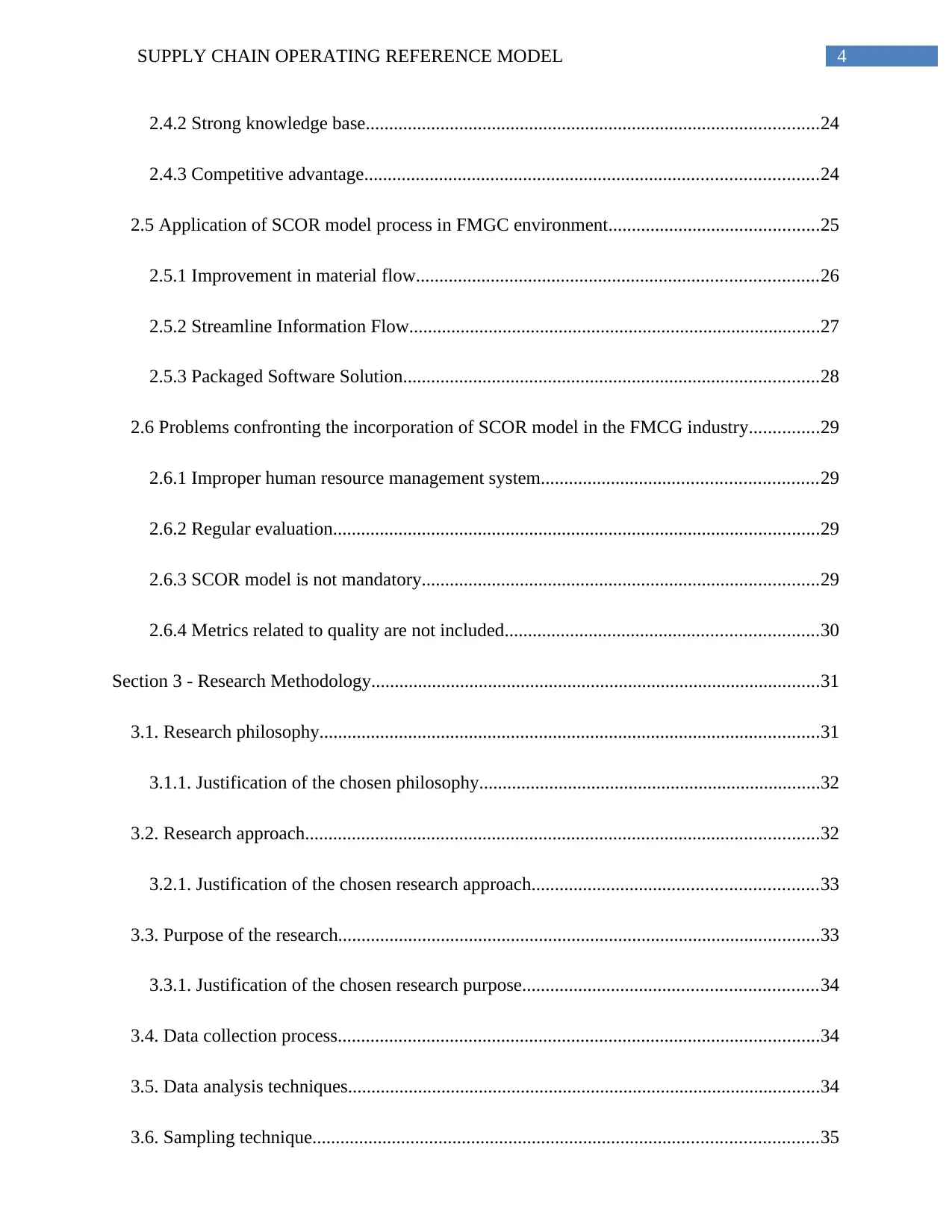
4SUPPLY CHAIN OPERATING REFERENCE MODEL
2.4.2 Strong knowledge base.................................................................................................24
2.4.3 Competitive advantage.................................................................................................24
2.5 Application of SCOR model process in FMGC environment.............................................25
2.5.1 Improvement in material flow......................................................................................26
2.5.2 Streamline Information Flow........................................................................................27
2.5.3 Packaged Software Solution.........................................................................................28
2.6 Problems confronting the incorporation of SCOR model in the FMCG industry...............29
2.6.1 Improper human resource management system...........................................................29
2.6.2 Regular evaluation........................................................................................................29
2.6.3 SCOR model is not mandatory.....................................................................................29
2.6.4 Metrics related to quality are not included...................................................................30
Section 3 - Research Methodology................................................................................................31
3.1. Research philosophy...........................................................................................................31
3.1.1. Justification of the chosen philosophy.........................................................................32
3.2. Research approach..............................................................................................................32
3.2.1. Justification of the chosen research approach.............................................................33
3.3. Purpose of the research.......................................................................................................33
3.3.1. Justification of the chosen research purpose...............................................................34
3.4. Data collection process.......................................................................................................34
3.5. Data analysis techniques.....................................................................................................34
3.6. Sampling technique............................................................................................................35
2.4.2 Strong knowledge base.................................................................................................24
2.4.3 Competitive advantage.................................................................................................24
2.5 Application of SCOR model process in FMGC environment.............................................25
2.5.1 Improvement in material flow......................................................................................26
2.5.2 Streamline Information Flow........................................................................................27
2.5.3 Packaged Software Solution.........................................................................................28
2.6 Problems confronting the incorporation of SCOR model in the FMCG industry...............29
2.6.1 Improper human resource management system...........................................................29
2.6.2 Regular evaluation........................................................................................................29
2.6.3 SCOR model is not mandatory.....................................................................................29
2.6.4 Metrics related to quality are not included...................................................................30
Section 3 - Research Methodology................................................................................................31
3.1. Research philosophy...........................................................................................................31
3.1.1. Justification of the chosen philosophy.........................................................................32
3.2. Research approach..............................................................................................................32
3.2.1. Justification of the chosen research approach.............................................................33
3.3. Purpose of the research.......................................................................................................33
3.3.1. Justification of the chosen research purpose...............................................................34
3.4. Data collection process.......................................................................................................34
3.5. Data analysis techniques.....................................................................................................34
3.6. Sampling technique............................................................................................................35
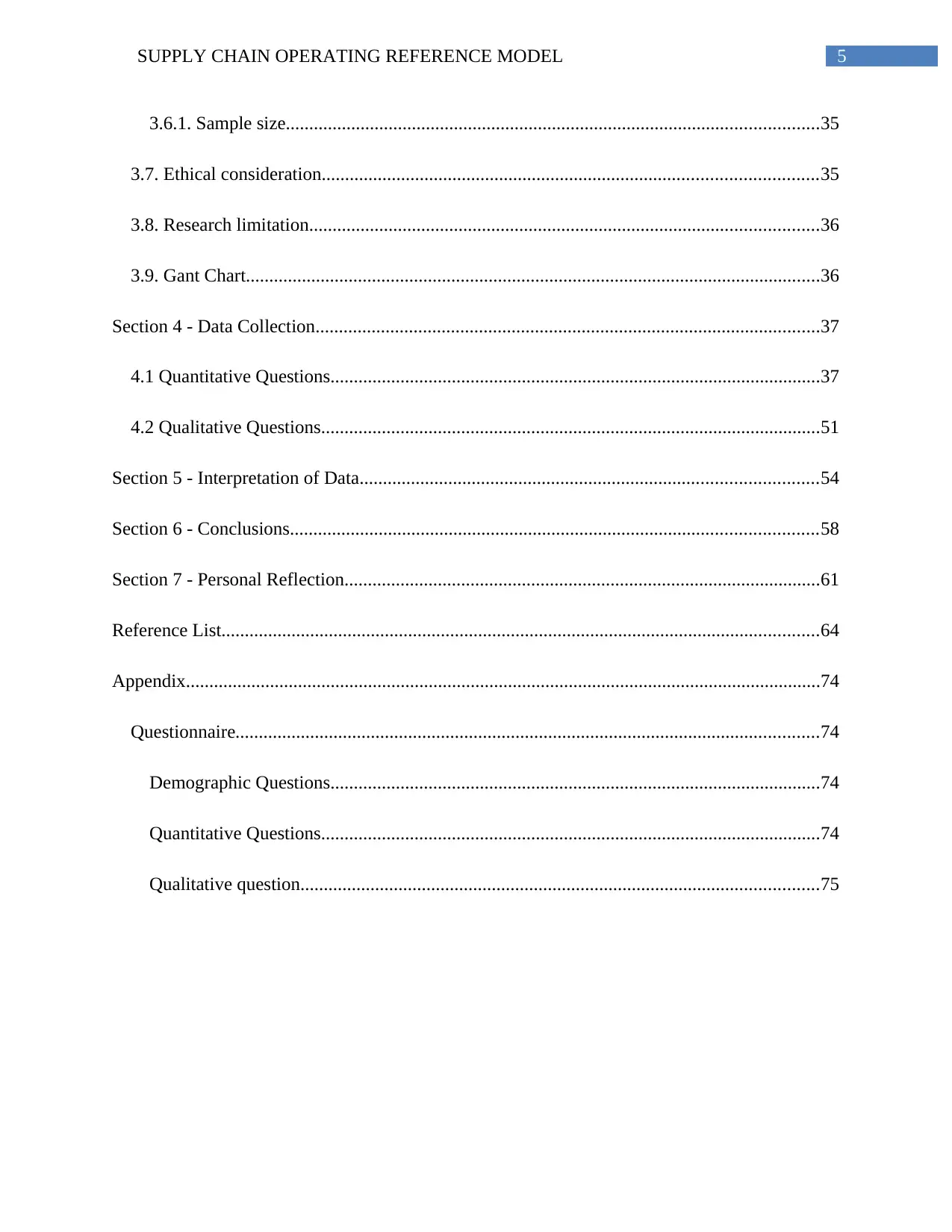
5SUPPLY CHAIN OPERATING REFERENCE MODEL
3.6.1. Sample size..................................................................................................................35
3.7. Ethical consideration..........................................................................................................35
3.8. Research limitation.............................................................................................................36
3.9. Gant Chart...........................................................................................................................36
Section 4 - Data Collection............................................................................................................37
4.1 Quantitative Questions.........................................................................................................37
4.2 Qualitative Questions...........................................................................................................51
Section 5 - Interpretation of Data..................................................................................................54
Section 6 - Conclusions.................................................................................................................58
Section 7 - Personal Reflection......................................................................................................61
Reference List................................................................................................................................64
Appendix........................................................................................................................................74
Questionnaire.............................................................................................................................74
Demographic Questions.........................................................................................................74
Quantitative Questions...........................................................................................................74
Qualitative question...............................................................................................................75
3.6.1. Sample size..................................................................................................................35
3.7. Ethical consideration..........................................................................................................35
3.8. Research limitation.............................................................................................................36
3.9. Gant Chart...........................................................................................................................36
Section 4 - Data Collection............................................................................................................37
4.1 Quantitative Questions.........................................................................................................37
4.2 Qualitative Questions...........................................................................................................51
Section 5 - Interpretation of Data..................................................................................................54
Section 6 - Conclusions.................................................................................................................58
Section 7 - Personal Reflection......................................................................................................61
Reference List................................................................................................................................64
Appendix........................................................................................................................................74
Questionnaire.............................................................................................................................74
Demographic Questions.........................................................................................................74
Quantitative Questions...........................................................................................................74
Qualitative question...............................................................................................................75
⊘ This is a preview!⊘
Do you want full access?
Subscribe today to unlock all pages.

Trusted by 1+ million students worldwide
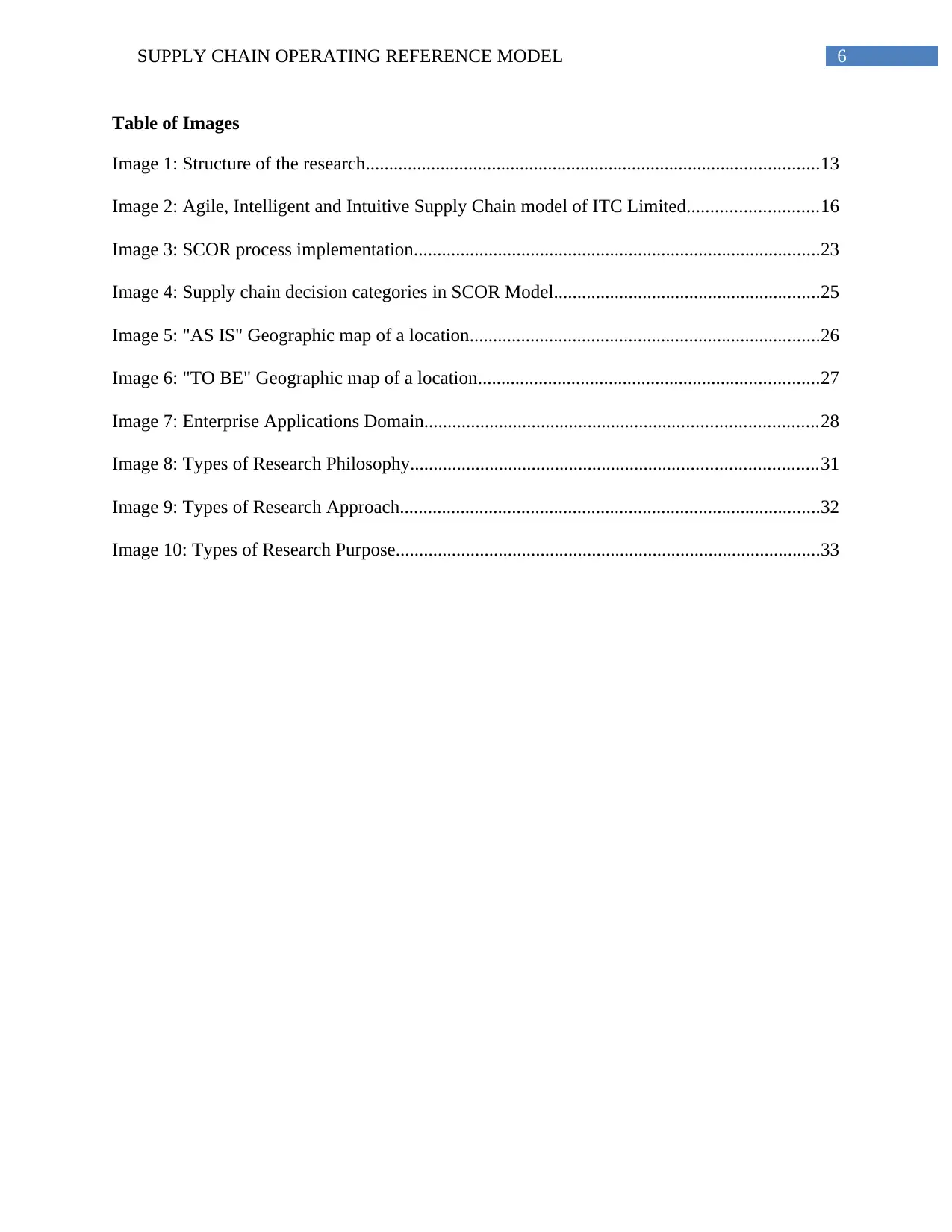
6SUPPLY CHAIN OPERATING REFERENCE MODEL
Table of Images
Image 1: Structure of the research.................................................................................................13
Image 2: Agile, Intelligent and Intuitive Supply Chain model of ITC Limited............................16
Image 3: SCOR process implementation.......................................................................................23
Image 4: Supply chain decision categories in SCOR Model.........................................................25
Image 5: "AS IS" Geographic map of a location...........................................................................26
Image 6: "TO BE" Geographic map of a location.........................................................................27
Image 7: Enterprise Applications Domain....................................................................................28
Image 8: Types of Research Philosophy.......................................................................................31
Image 9: Types of Research Approach..........................................................................................32
Image 10: Types of Research Purpose...........................................................................................33
Table of Images
Image 1: Structure of the research.................................................................................................13
Image 2: Agile, Intelligent and Intuitive Supply Chain model of ITC Limited............................16
Image 3: SCOR process implementation.......................................................................................23
Image 4: Supply chain decision categories in SCOR Model.........................................................25
Image 5: "AS IS" Geographic map of a location...........................................................................26
Image 6: "TO BE" Geographic map of a location.........................................................................27
Image 7: Enterprise Applications Domain....................................................................................28
Image 8: Types of Research Philosophy.......................................................................................31
Image 9: Types of Research Approach..........................................................................................32
Image 10: Types of Research Purpose...........................................................................................33
Paraphrase This Document
Need a fresh take? Get an instant paraphrase of this document with our AI Paraphraser
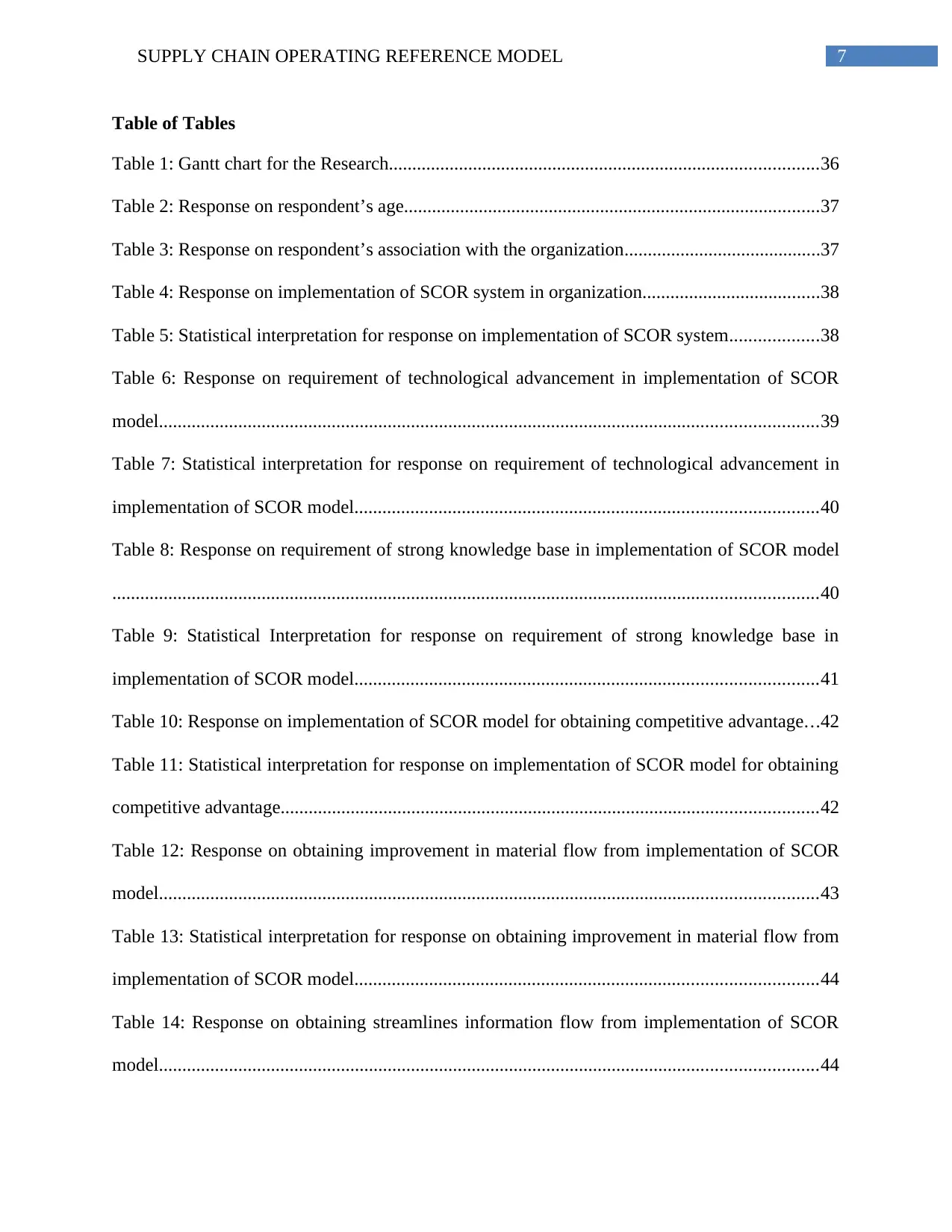
7SUPPLY CHAIN OPERATING REFERENCE MODEL
Table of Tables
Table 1: Gantt chart for the Research............................................................................................36
Table 2: Response on respondent’s age.........................................................................................37
Table 3: Response on respondent’s association with the organization..........................................37
Table 4: Response on implementation of SCOR system in organization......................................38
Table 5: Statistical interpretation for response on implementation of SCOR system...................38
Table 6: Response on requirement of technological advancement in implementation of SCOR
model.............................................................................................................................................39
Table 7: Statistical interpretation for response on requirement of technological advancement in
implementation of SCOR model...................................................................................................40
Table 8: Response on requirement of strong knowledge base in implementation of SCOR model
.......................................................................................................................................................40
Table 9: Statistical Interpretation for response on requirement of strong knowledge base in
implementation of SCOR model...................................................................................................41
Table 10: Response on implementation of SCOR model for obtaining competitive advantage...42
Table 11: Statistical interpretation for response on implementation of SCOR model for obtaining
competitive advantage...................................................................................................................42
Table 12: Response on obtaining improvement in material flow from implementation of SCOR
model.............................................................................................................................................43
Table 13: Statistical interpretation for response on obtaining improvement in material flow from
implementation of SCOR model...................................................................................................44
Table 14: Response on obtaining streamlines information flow from implementation of SCOR
model.............................................................................................................................................44
Table of Tables
Table 1: Gantt chart for the Research............................................................................................36
Table 2: Response on respondent’s age.........................................................................................37
Table 3: Response on respondent’s association with the organization..........................................37
Table 4: Response on implementation of SCOR system in organization......................................38
Table 5: Statistical interpretation for response on implementation of SCOR system...................38
Table 6: Response on requirement of technological advancement in implementation of SCOR
model.............................................................................................................................................39
Table 7: Statistical interpretation for response on requirement of technological advancement in
implementation of SCOR model...................................................................................................40
Table 8: Response on requirement of strong knowledge base in implementation of SCOR model
.......................................................................................................................................................40
Table 9: Statistical Interpretation for response on requirement of strong knowledge base in
implementation of SCOR model...................................................................................................41
Table 10: Response on implementation of SCOR model for obtaining competitive advantage...42
Table 11: Statistical interpretation for response on implementation of SCOR model for obtaining
competitive advantage...................................................................................................................42
Table 12: Response on obtaining improvement in material flow from implementation of SCOR
model.............................................................................................................................................43
Table 13: Statistical interpretation for response on obtaining improvement in material flow from
implementation of SCOR model...................................................................................................44
Table 14: Response on obtaining streamlines information flow from implementation of SCOR
model.............................................................................................................................................44
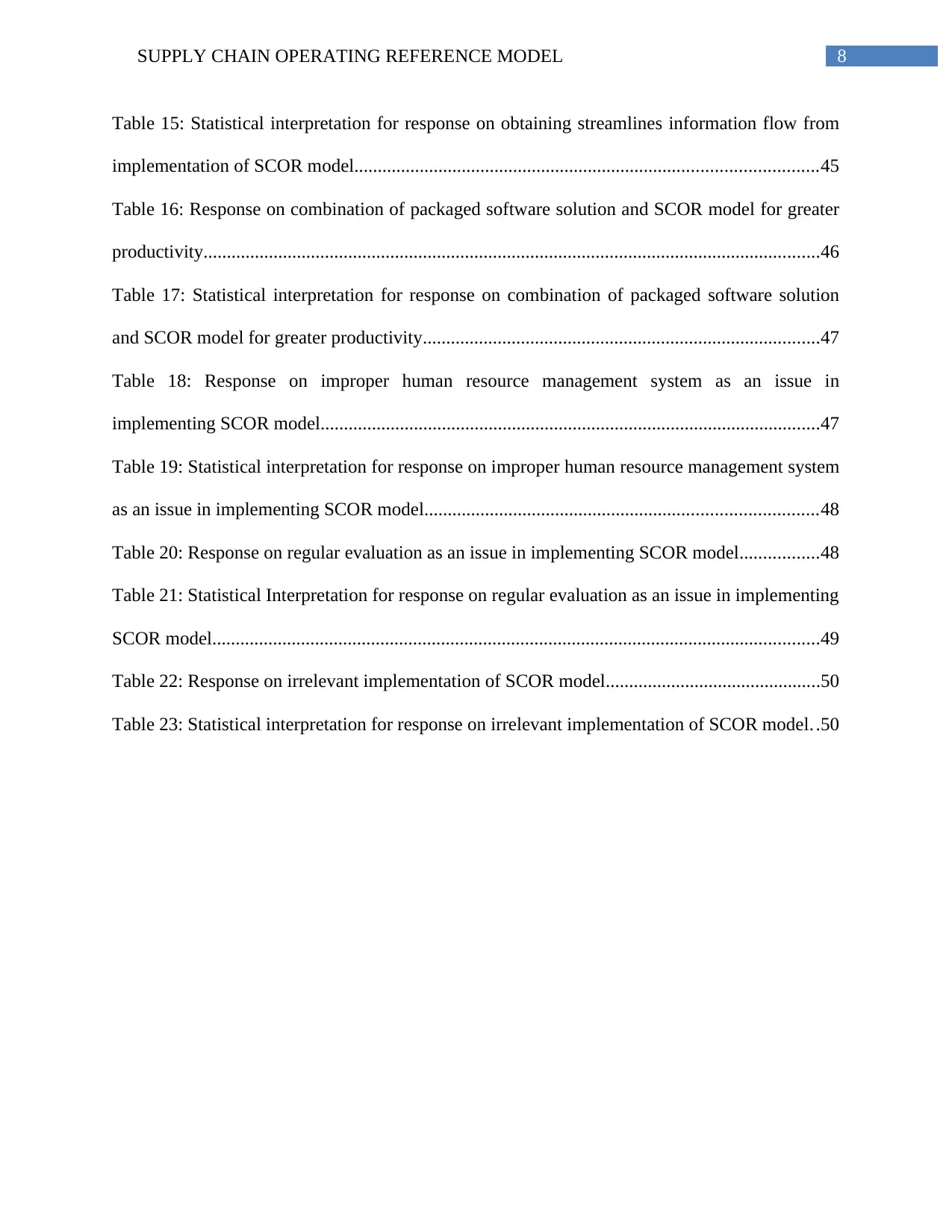
8SUPPLY CHAIN OPERATING REFERENCE MODEL
Table 15: Statistical interpretation for response on obtaining streamlines information flow from
implementation of SCOR model...................................................................................................45
Table 16: Response on combination of packaged software solution and SCOR model for greater
productivity....................................................................................................................................46
Table 17: Statistical interpretation for response on combination of packaged software solution
and SCOR model for greater productivity.....................................................................................47
Table 18: Response on improper human resource management system as an issue in
implementing SCOR model...........................................................................................................47
Table 19: Statistical interpretation for response on improper human resource management system
as an issue in implementing SCOR model....................................................................................48
Table 20: Response on regular evaluation as an issue in implementing SCOR model.................48
Table 21: Statistical Interpretation for response on regular evaluation as an issue in implementing
SCOR model..................................................................................................................................49
Table 22: Response on irrelevant implementation of SCOR model..............................................50
Table 23: Statistical interpretation for response on irrelevant implementation of SCOR model. .50
Table 15: Statistical interpretation for response on obtaining streamlines information flow from
implementation of SCOR model...................................................................................................45
Table 16: Response on combination of packaged software solution and SCOR model for greater
productivity....................................................................................................................................46
Table 17: Statistical interpretation for response on combination of packaged software solution
and SCOR model for greater productivity.....................................................................................47
Table 18: Response on improper human resource management system as an issue in
implementing SCOR model...........................................................................................................47
Table 19: Statistical interpretation for response on improper human resource management system
as an issue in implementing SCOR model....................................................................................48
Table 20: Response on regular evaluation as an issue in implementing SCOR model.................48
Table 21: Statistical Interpretation for response on regular evaluation as an issue in implementing
SCOR model..................................................................................................................................49
Table 22: Response on irrelevant implementation of SCOR model..............................................50
Table 23: Statistical interpretation for response on irrelevant implementation of SCOR model. .50
⊘ This is a preview!⊘
Do you want full access?
Subscribe today to unlock all pages.

Trusted by 1+ million students worldwide
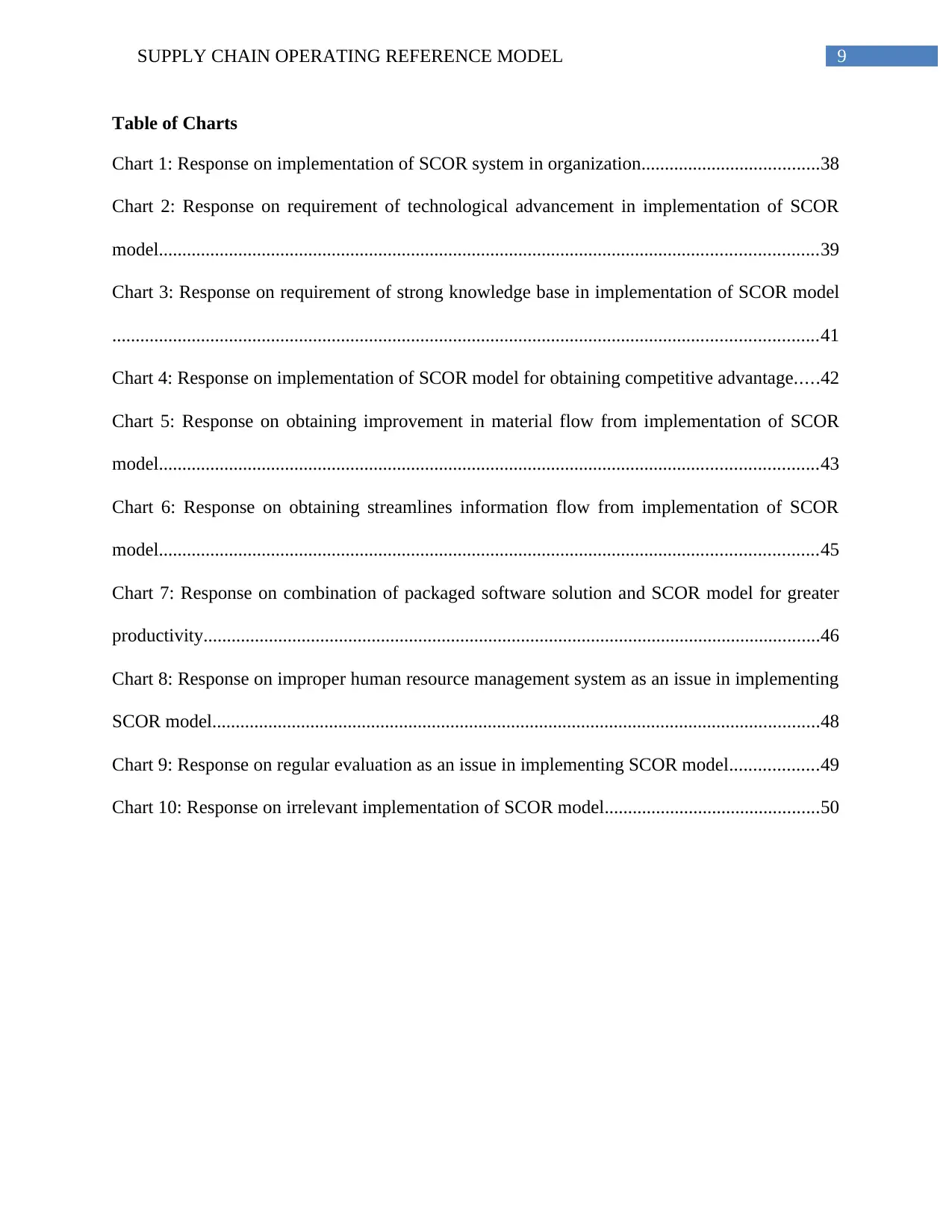
9SUPPLY CHAIN OPERATING REFERENCE MODEL
Table of Charts
Chart 1: Response on implementation of SCOR system in organization......................................38
Chart 2: Response on requirement of technological advancement in implementation of SCOR
model.............................................................................................................................................39
Chart 3: Response on requirement of strong knowledge base in implementation of SCOR model
.......................................................................................................................................................41
Chart 4: Response on implementation of SCOR model for obtaining competitive advantage.....42
Chart 5: Response on obtaining improvement in material flow from implementation of SCOR
model.............................................................................................................................................43
Chart 6: Response on obtaining streamlines information flow from implementation of SCOR
model.............................................................................................................................................45
Chart 7: Response on combination of packaged software solution and SCOR model for greater
productivity....................................................................................................................................46
Chart 8: Response on improper human resource management system as an issue in implementing
SCOR model..................................................................................................................................48
Chart 9: Response on regular evaluation as an issue in implementing SCOR model...................49
Chart 10: Response on irrelevant implementation of SCOR model..............................................50
Table of Charts
Chart 1: Response on implementation of SCOR system in organization......................................38
Chart 2: Response on requirement of technological advancement in implementation of SCOR
model.............................................................................................................................................39
Chart 3: Response on requirement of strong knowledge base in implementation of SCOR model
.......................................................................................................................................................41
Chart 4: Response on implementation of SCOR model for obtaining competitive advantage.....42
Chart 5: Response on obtaining improvement in material flow from implementation of SCOR
model.............................................................................................................................................43
Chart 6: Response on obtaining streamlines information flow from implementation of SCOR
model.............................................................................................................................................45
Chart 7: Response on combination of packaged software solution and SCOR model for greater
productivity....................................................................................................................................46
Chart 8: Response on improper human resource management system as an issue in implementing
SCOR model..................................................................................................................................48
Chart 9: Response on regular evaluation as an issue in implementing SCOR model...................49
Chart 10: Response on irrelevant implementation of SCOR model..............................................50
Paraphrase This Document
Need a fresh take? Get an instant paraphrase of this document with our AI Paraphraser
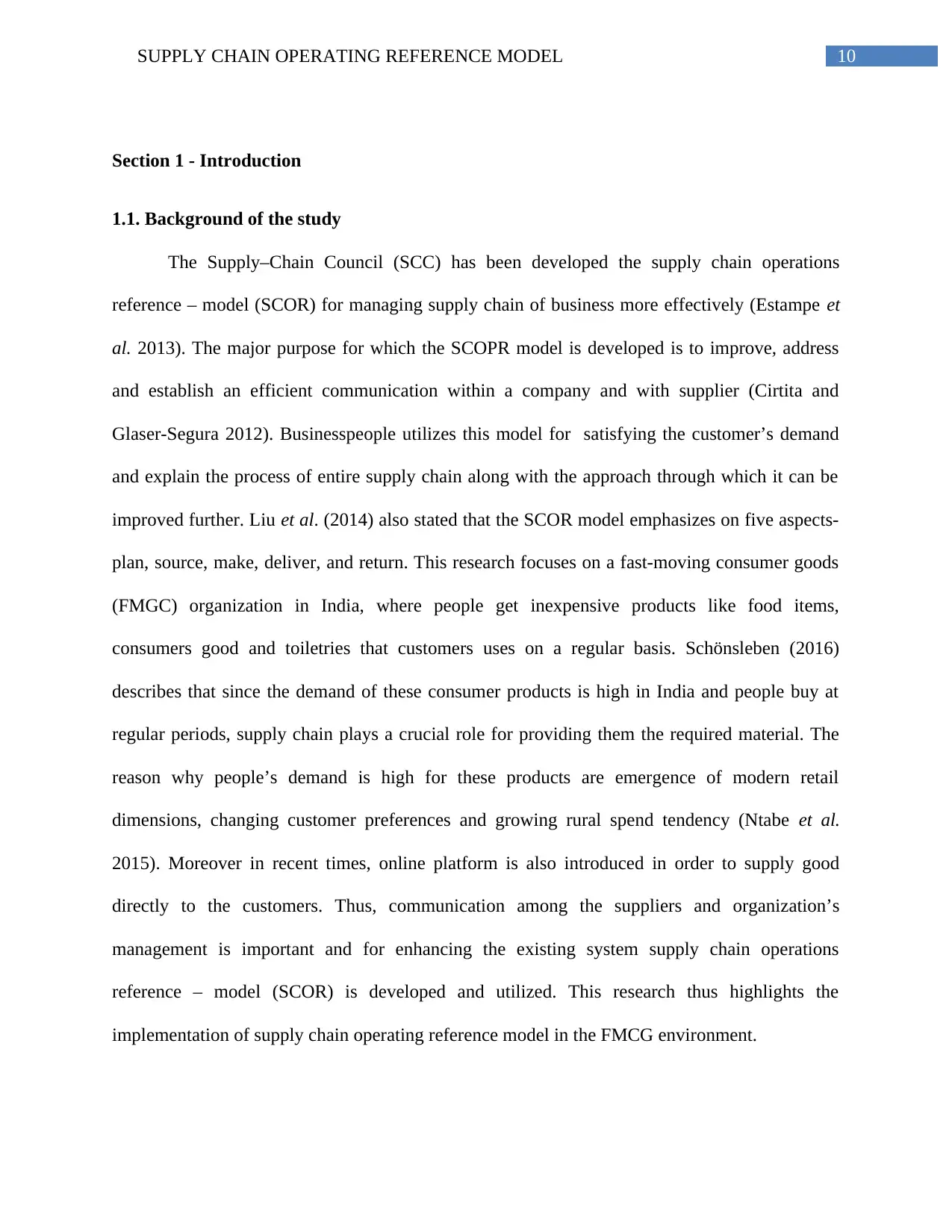
10SUPPLY CHAIN OPERATING REFERENCE MODEL
Section 1 - Introduction
1.1. Background of the study
The Supply–Chain Council (SCC) has been developed the supply chain operations
reference – model (SCOR) for managing supply chain of business more effectively (Estampe et
al. 2013). The major purpose for which the SCOPR model is developed is to improve, address
and establish an efficient communication within a company and with supplier (Cirtita and
Glaser-Segura 2012). Businesspeople utilizes this model for satisfying the customer’s demand
and explain the process of entire supply chain along with the approach through which it can be
improved further. Liu et al. (2014) also stated that the SCOR model emphasizes on five aspects-
plan, source, make, deliver, and return. This research focuses on a fast-moving consumer goods
(FMGC) organization in India, where people get inexpensive products like food items,
consumers good and toiletries that customers uses on a regular basis. Schönsleben (2016)
describes that since the demand of these consumer products is high in India and people buy at
regular periods, supply chain plays a crucial role for providing them the required material. The
reason why people’s demand is high for these products are emergence of modern retail
dimensions, changing customer preferences and growing rural spend tendency (Ntabe et al.
2015). Moreover in recent times, online platform is also introduced in order to supply good
directly to the customers. Thus, communication among the suppliers and organization’s
management is important and for enhancing the existing system supply chain operations
reference – model (SCOR) is developed and utilized. This research thus highlights the
implementation of supply chain operating reference model in the FMCG environment.
Section 1 - Introduction
1.1. Background of the study
The Supply–Chain Council (SCC) has been developed the supply chain operations
reference – model (SCOR) for managing supply chain of business more effectively (Estampe et
al. 2013). The major purpose for which the SCOPR model is developed is to improve, address
and establish an efficient communication within a company and with supplier (Cirtita and
Glaser-Segura 2012). Businesspeople utilizes this model for satisfying the customer’s demand
and explain the process of entire supply chain along with the approach through which it can be
improved further. Liu et al. (2014) also stated that the SCOR model emphasizes on five aspects-
plan, source, make, deliver, and return. This research focuses on a fast-moving consumer goods
(FMGC) organization in India, where people get inexpensive products like food items,
consumers good and toiletries that customers uses on a regular basis. Schönsleben (2016)
describes that since the demand of these consumer products is high in India and people buy at
regular periods, supply chain plays a crucial role for providing them the required material. The
reason why people’s demand is high for these products are emergence of modern retail
dimensions, changing customer preferences and growing rural spend tendency (Ntabe et al.
2015). Moreover in recent times, online platform is also introduced in order to supply good
directly to the customers. Thus, communication among the suppliers and organization’s
management is important and for enhancing the existing system supply chain operations
reference – model (SCOR) is developed and utilized. This research thus highlights the
implementation of supply chain operating reference model in the FMCG environment.
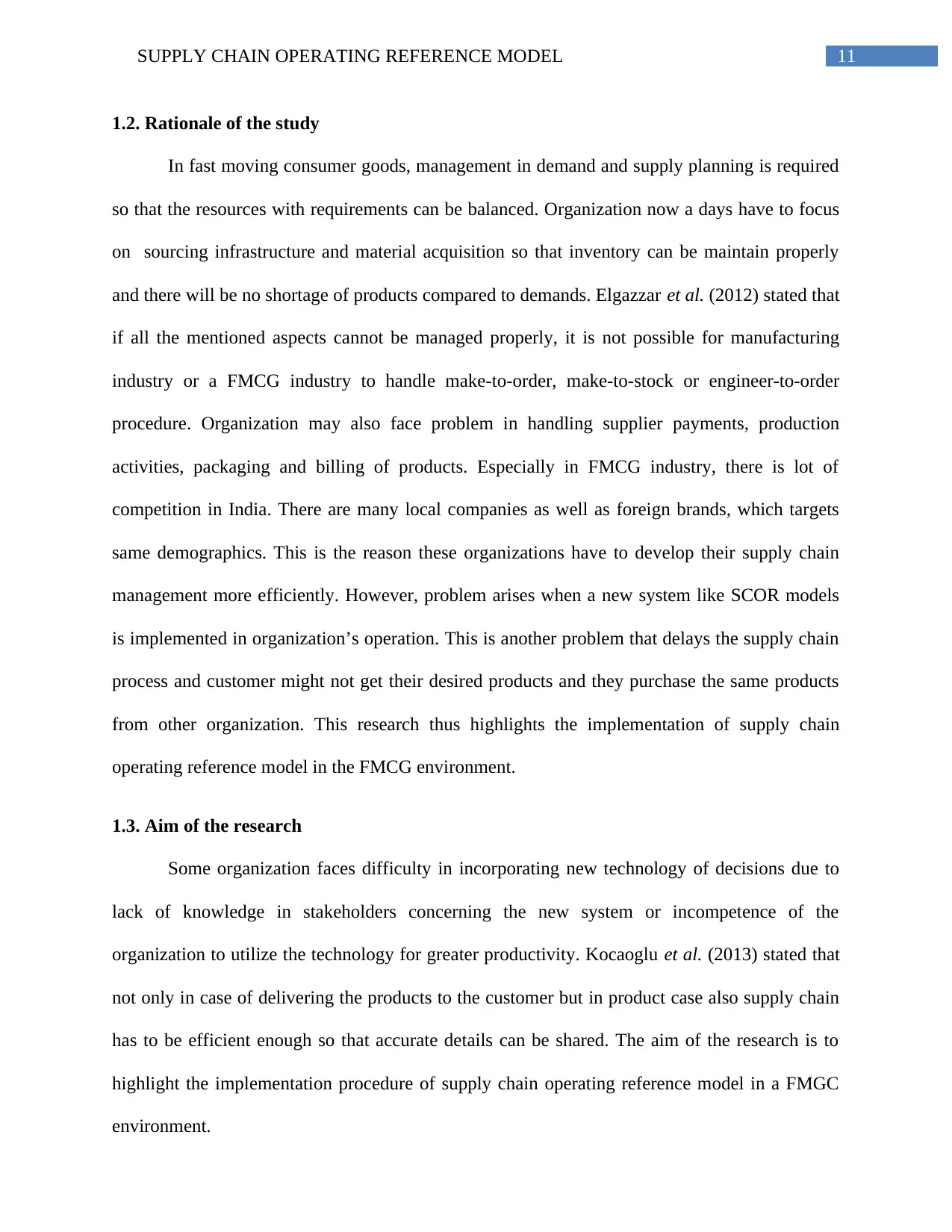
11SUPPLY CHAIN OPERATING REFERENCE MODEL
1.2. Rationale of the study
In fast moving consumer goods, management in demand and supply planning is required
so that the resources with requirements can be balanced. Organization now a days have to focus
on sourcing infrastructure and material acquisition so that inventory can be maintain properly
and there will be no shortage of products compared to demands. Elgazzar et al. (2012) stated that
if all the mentioned aspects cannot be managed properly, it is not possible for manufacturing
industry or a FMCG industry to handle make-to-order, make-to-stock or engineer-to-order
procedure. Organization may also face problem in handling supplier payments, production
activities, packaging and billing of products. Especially in FMCG industry, there is lot of
competition in India. There are many local companies as well as foreign brands, which targets
same demographics. This is the reason these organizations have to develop their supply chain
management more efficiently. However, problem arises when a new system like SCOR models
is implemented in organization’s operation. This is another problem that delays the supply chain
process and customer might not get their desired products and they purchase the same products
from other organization. This research thus highlights the implementation of supply chain
operating reference model in the FMCG environment.
1.3. Aim of the research
Some organization faces difficulty in incorporating new technology of decisions due to
lack of knowledge in stakeholders concerning the new system or incompetence of the
organization to utilize the technology for greater productivity. Kocaoglu et al. (2013) stated that
not only in case of delivering the products to the customer but in product case also supply chain
has to be efficient enough so that accurate details can be shared. The aim of the research is to
highlight the implementation procedure of supply chain operating reference model in a FMGC
environment.
1.2. Rationale of the study
In fast moving consumer goods, management in demand and supply planning is required
so that the resources with requirements can be balanced. Organization now a days have to focus
on sourcing infrastructure and material acquisition so that inventory can be maintain properly
and there will be no shortage of products compared to demands. Elgazzar et al. (2012) stated that
if all the mentioned aspects cannot be managed properly, it is not possible for manufacturing
industry or a FMCG industry to handle make-to-order, make-to-stock or engineer-to-order
procedure. Organization may also face problem in handling supplier payments, production
activities, packaging and billing of products. Especially in FMCG industry, there is lot of
competition in India. There are many local companies as well as foreign brands, which targets
same demographics. This is the reason these organizations have to develop their supply chain
management more efficiently. However, problem arises when a new system like SCOR models
is implemented in organization’s operation. This is another problem that delays the supply chain
process and customer might not get their desired products and they purchase the same products
from other organization. This research thus highlights the implementation of supply chain
operating reference model in the FMCG environment.
1.3. Aim of the research
Some organization faces difficulty in incorporating new technology of decisions due to
lack of knowledge in stakeholders concerning the new system or incompetence of the
organization to utilize the technology for greater productivity. Kocaoglu et al. (2013) stated that
not only in case of delivering the products to the customer but in product case also supply chain
has to be efficient enough so that accurate details can be shared. The aim of the research is to
highlight the implementation procedure of supply chain operating reference model in a FMGC
environment.
⊘ This is a preview!⊘
Do you want full access?
Subscribe today to unlock all pages.

Trusted by 1+ million students worldwide
1 out of 73
Related Documents
Your All-in-One AI-Powered Toolkit for Academic Success.
+13062052269
info@desklib.com
Available 24*7 on WhatsApp / Email
![[object Object]](/_next/static/media/star-bottom.7253800d.svg)
Unlock your academic potential
Copyright © 2020–2025 A2Z Services. All Rights Reserved. Developed and managed by ZUCOL.




